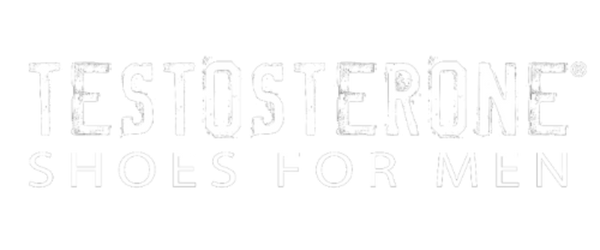Shoe Care Guide
How to Care for Your Testosterone Shoes
Testosterone Shoes are crafted from premium materials for comfort, style, and durability. Here are some handy care tips to help you enjoy your footwear for years to come.
Storage
- Do not store your shoes in shoe boxes for long periods of time. It can cause certain materials to deteriorate, especially in humid climates.
- Once you take your shoes off for the day, place cedar shoetrees into them and leave them in until the next wearing.
- Store shoes at room temperature, away from heaters. Heaters can dry out leather and cause it to crack, or harm adhesives.
- Every once in a while, give your favorite pair of shoes the day off so they can air out.
Polishing
1. Wipe your shoes down with a damp cloth to remove superficial dirt and stains.
2. Wet the welt brush and scrub out the entire welt strip.
3. If the shoes need it, apply sole-edge dressing — carefully. If you get it on the uppers, it will stain them permanently. Let edge dressing dry before going any further.
4. Apply polish, using a circular rubbing motion. You don't need to slather it on. You don't need to be gentle. And the more you rub, the better. Let the polish dry. It should take about five minutes.
5. Buff the entire shoe with a polishing brush. For extra gleam, hold the shoe between your knees and buff the toe vigorously with a lint-free cloth.
Cleaning
Full-Grain (regular) Leather
- Wipe gently with dry cloth to remove dried-on dirt and dust. Then, dampen cloth with warm water and wipe again.
- Allow leather to dry naturally away from direct sunlight and heat sources (like heat vents)
- Use high-quality polish that matches shoe color and buff to a shine
- Avoid liquid shoe polishes and silicone sprays
Patent Leather
- Use soft damp cloth and drop of mild soap to remove haze.
- Use patent leather cleaner with silicone to restore high gloss.
Suede
- Since you can’t polish away any scuff marks on suede, use a suede eraser (basically a brick of crumbly rubber) to rub away small blemishes. Then use a suede brush to restore the nap, or fuzz, of the leather.
- Use rubber eraser to remove dirt and smudges. Then, brush lightly with soft brush specifically designed for suede and nubuck products.
- Brush in the same direction to avoid giving the appearance of being two different colors.
- Never use wire brush or polish on suede and nubuck. (Some suede brushes have wire in the center, but this is specially designed for suede.)
- Follow up with a silicone spray for water and stain resistance.
Waxy/Oiled Leathers
- Gently wipe with dry cloth to remove dried-on dirt and dust. Then, apply a cleaner such as Penguin P100 Instant Cleaner (available at most athletic/sporting goods stores).
- Allow leather to dry naturally away from direct sunlight and heat sources (like heat vents)
- Apply leather protector and restorer, which are composed of oils and other non-water-soluble compounds like lanolin. (This may darken the color of beeswax leather.)
Weatherproofing
- We suggest a non-silicone spray or a rain/stain repellent.
- Stuff soaking-wet shoes with newspaper and dry them away from direct heat. Don’t use direct heat – it can cause leather to crack, which can’t be fixed.
- Before wet shoes are entirely dry, insert cedar shoetrees to make sure they dry out evenly and maintain their shape.
- For beeswax leather, a leather protector and restorer with lanolin will help guard against water damage.
Deodorizing
- Don’t wear the same pair of shoes every day.
- Insert unvarnished shoetrees into just-removed shoes to absorb perspiration and deodorize shoes.
- If needed, have cobbler replace insoles.
Shoe Care Tools
- Shoe polish: We recommend wax-based polish. Cream polishes are easier to use, but don’t offer the same shiny result. Basic colors – black, chestnut, and tan are good ones to have. Do not use this on suede or nubuck. With all chemicals, pre-test on inconspicuous area first.
- Welt brush: It's designed to get the grit out of the welt, the seam where the shoe's upper joins the sole. In a pinch, you can use a toothbrush instead.
- Polishing cloth: In lint-free cotton or linen. Use the same one for putting on the polish that you use for buffing, regardless of the color you're using. And hang on to it: The longer you use the same cloth, the more it becomes permeated with rich oils and dyes.
- Polishing brush: Horsehair is best to work polish into the leather, remove excess polish on the shoe, and get a shiny result. Use a dark color for darker polishes and a lighter color for lighter polishes.
- Shoetree: Cedar with split toe and fully shaped heel. Did you know a shoetree can extend the life of your shoes up to 30% or more? Shoetrees help absorb moisture, draw leather back to its original shape, eliminate fine lines where the shoe flexes, and promote even wear of shoes. Plastic or metal shoetrees do not achieve the drying effect and are not recommended.
- Heel and sole edge dressing: This is most commonly applied to dress shoes with leather soles to helps restore the pristine look. Comes in black or brown and helps protect the outsole. Applied with a small craft brush or a cotton swab.
- Shoe horn: helps protect back of your shoes as you slide your foot in, maintaining its shape and fit.
- Shoe spray: protects the surface of the shoe, making it water-resistant and easier to clean. Non-silicone based to prevent changing the color of the footwear.
- Suede block and brush: used for erasing dirt and stains and to brush suede or nubuck. Use a fair amount of pressure when erasing stains and dirt. A brush restores the “fuzzy” feel of suede.
